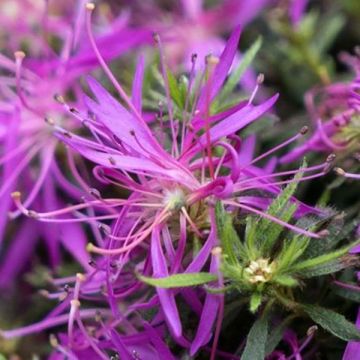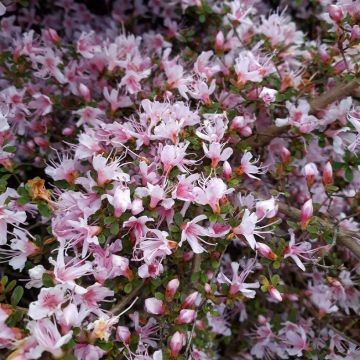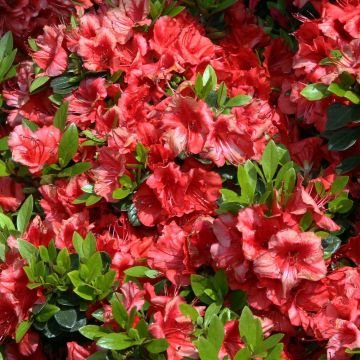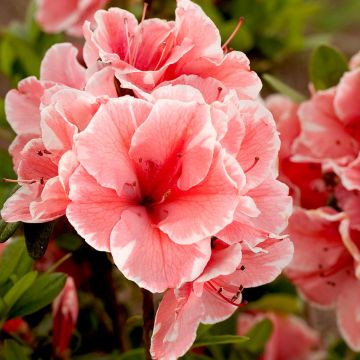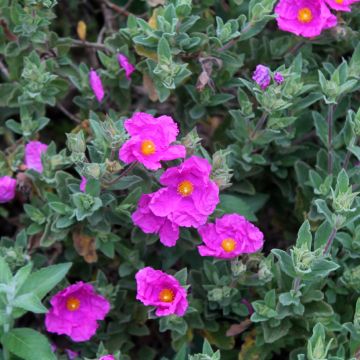

Azalée hybride - Azaleodendron (x) Gowenianum
Rhododendron x gowenianum - Gowen's Azalea
Rhododendron (Azalea) x gowenianum
Gowen's Azalea
Why not try an alternative variety in stock?
View all →This plant carries a 24 months recovery warranty
More information
We guarantee the quality of our plants for a full growing cycle, and will replace at our expense any plant that fails to recover under normal climatic and planting conditions.
From €5.90 for pickup delivery and €6.90 for home delivery
Express home delivery from €8.90.
Does this plant fit my garden?
Set up your Plantfit profile →
Description
Rhododendron x gowenianum, still very rare in cultivation, is an ancient hybrid variety between an azalea and a rhododendron. This plant charms with its delicate and original flowering, made up of a multitude of small mauve to pink star-shaped flowers that perfume a whole section of the garden. In late spring, it is a real pleasure to see them bloom in large numbers on its beautiful rhododendron leaves. With its lovely rounded habit and modest stature, this bush thrives in partial shade and acidic soil, making it perfectly suited for small spaces and container gardening.
Rhododendron x gowenianum is a result of cross-breeding between an evergreen Rhododendron and a deciduous azalea, carried out in the United Kingdom before 1825 by James Robert Gowen. Its parents are the Rhododendron periclymenoides or viscosum and the hybrid R. catawbiense x ponticum. It is a hardy evergreen shrub (up to -15°C), which performs well in our cool and humid temperate climates.
This Rhododendron forms a well-branched bush with a dense and globose habit, which measures about 1m (3ft 4in) in all directions at the age of 10 years. In optimal growing conditions, it can reach 1.50m (4ft 11in) in height. Its growth is slow. Its flowering, full of charm, takes place in early June, depending on the climate. The flowers, 2.5 to 3.5cm (1 to 1.4in) wide, gradually change from light mauve to lilac and soft pink. They have a funnel shape and are gathered in spherical terminal clusters, each of which can have 36 to 48 flowers. Their scent is intensely sweet. The foliage, more or less evergreen in winter, is composed of large, simple, elliptical leaves with entire margins, arranged alternately on the branches. Their colour is a fairly dark green with a slight shine. Some leaves fall in winter, some dry up in spring, while new shoots develop. Rhododendrons have a shallow root system, which should never lack moisture, but they fear stagnant humidity that suffocates them.
Rhodoodendrons thrive in cool and humid climates, with marked winters, planted in humus-rich and acidic soil, such as heather soil. Under these conditions, they are beautiful evergreen shrubs for borders or flowering pots, attractive all year round. They happily accompany heathers, Japanese maples, or their Chinese relatives, the changing colours of which vary with the seasons, as well as Japanese camellias and their graceful autumn-flowering cousins, the often fragrant hybrids of C. sasanqua. The gowenianum hybrid, which forms a beautiful rounded bush, allows for playing with heights and filling in the spaces left between large heather shrubs. It will work wonders in large borders, but also on the terrace or balcony, in a carefully chosen large pot.
Report an error about the product description
Rhododendron x gowenianum - Gowen's Azalea in pictures


Plant habit
Flowering
Foliage
Botanical data
Rhododendron (Azalea)
x gowenianum
Ericaceae
Gowen's Azalea
Cultivar or hybrid
Other Japanese Azalea
Planting and care
Rhododendron x gowenianum prefers a rather shady location, unlike the Chinese Azalea, but its favourite exposure is partial shade. It is a plant that thrives in a humid and cool climate, and does not tolerate heat, dry air, or excessively dry or waterlogged soils. Plant it in a soil enriched with compost or humus, well-drained, and above all, non-calcareous. When planting, make sure not to bury the root ball too deeply, it should be level with the ground. Water generously during dry periods, at least once a week during the first year, with non-calcareous water.
In spring, apply fertilizer for plants that prefer acidic soil. After flowering, perform light pruning to maintain a neat plant, even though pruning is not essential. Remove faded flowers to promote the emergence of new shoots. Azalea have few diseases when well-established outdoors and in suitable climate conditions. It can be attacked by leaf-eating caterpillars and by the famous "rhododendron leafhopper," which rarely causes significant damage. If this is the case, treat with carbofuran. If the soil is calcareous or poorly drained, and if the plant is planted too deeply, the leaves may turn yellow and eventually wither.
Planting period
Intended location
Care
This item has not been reviewed yet - be the first to leave a review about it.
Evergreen shrubs
Haven't found what you were looking for?
Hardiness is the lowest winter temperature a plant can endure without suffering serious damage or even dying. However, hardiness is affected by location (a sheltered area, such as a patio), protection (winter cover) and soil type (hardiness is improved by well-drained soil).

Photo Sharing Terms & Conditions
In order to encourage gardeners to interact and share their experiences, Promesse de fleurs offers various media enabling content to be uploaded onto its Site - in particular via the ‘Photo sharing’ module.
The User agrees to refrain from:
- Posting any content that is illegal, prejudicial, insulting, racist, inciteful to hatred, revisionist, contrary to public decency, that infringes on privacy or on the privacy rights of third parties, in particular the publicity rights of persons and goods, intellectual property rights, or the right to privacy.
- Submitting content on behalf of a third party;
- Impersonate the identity of a third party and/or publish any personal information about a third party;
In general, the User undertakes to refrain from any unethical behaviour.
All Content (in particular text, comments, files, images, photos, videos, creative works, etc.), which may be subject to property or intellectual property rights, image or other private rights, shall remain the property of the User, subject to the limited rights granted by the terms of the licence granted by Promesse de fleurs as stated below. Users are at liberty to publish or not to publish such Content on the Site, notably via the ‘Photo Sharing’ facility, and accept that this Content shall be made public and freely accessible, notably on the Internet.
Users further acknowledge, undertake to have ,and guarantee that they hold all necessary rights and permissions to publish such material on the Site, in particular with regard to the legislation in force pertaining to any privacy, property, intellectual property, image, or contractual rights, or rights of any other nature. By publishing such Content on the Site, Users acknowledge accepting full liability as publishers of the Content within the meaning of the law, and grant Promesse de fleurs, free of charge, an inclusive, worldwide licence for the said Content for the entire duration of its publication, including all reproduction, representation, up/downloading, displaying, performing, transmission, and storage rights.
Users also grant permission for their name to be linked to the Content and accept that this link may not always be made available.
By engaging in posting material, Users consent to their Content becoming automatically accessible on the Internet, in particular on other sites and/or blogs and/or web pages of the Promesse de fleurs site, including in particular social pages and the Promesse de fleurs catalogue.
Users may secure the removal of entrusted content free of charge by issuing a simple request via our contact form.
The flowering period indicated on our website applies to countries and regions located in USDA zone 8 (France, the United Kingdom, Ireland, the Netherlands, etc.)
It will vary according to where you live:
- In zones 9 to 10 (Italy, Spain, Greece, etc.), flowering will occur about 2 to 4 weeks earlier.
- In zones 6 to 7 (Germany, Poland, Slovenia, and lower mountainous regions), flowering will be delayed by 2 to 3 weeks.
- In zone 5 (Central Europe, Scandinavia), blooming will be delayed by 3 to 5 weeks.
In temperate climates, pruning of spring-flowering shrubs (forsythia, spireas, etc.) should be done just after flowering.
Pruning of summer-flowering shrubs (Indian Lilac, Perovskia, etc.) can be done in winter or spring.
In cold regions as well as with frost-sensitive plants, avoid pruning too early when severe frosts may still occur.
The planting period indicated on our website applies to countries and regions located in USDA zone 8 (France, United Kingdom, Ireland, Netherlands).
It will vary according to where you live:
- In Mediterranean zones (Marseille, Madrid, Milan, etc.), autumn and winter are the best planting periods.
- In continental zones (Strasbourg, Munich, Vienna, etc.), delay planting by 2 to 3 weeks in spring and bring it forward by 2 to 4 weeks in autumn.
- In mountainous regions (the Alps, Pyrenees, Carpathians, etc.), it is best to plant in late spring (May-June) or late summer (August-September).
The harvesting period indicated on our website applies to countries and regions in USDA zone 8 (France, England, Ireland, the Netherlands).
In colder areas (Scandinavia, Poland, Austria...) fruit and vegetable harvests are likely to be delayed by 3-4 weeks.
In warmer areas (Italy, Spain, Greece, etc.), harvesting will probably take place earlier, depending on weather conditions.
The sowing periods indicated on our website apply to countries and regions within USDA Zone 8 (France, UK, Ireland, Netherlands).
In colder areas (Scandinavia, Poland, Austria...), delay any outdoor sowing by 3-4 weeks, or sow under glass.
In warmer climes (Italy, Spain, Greece, etc.), bring outdoor sowing forward by a few weeks.


































